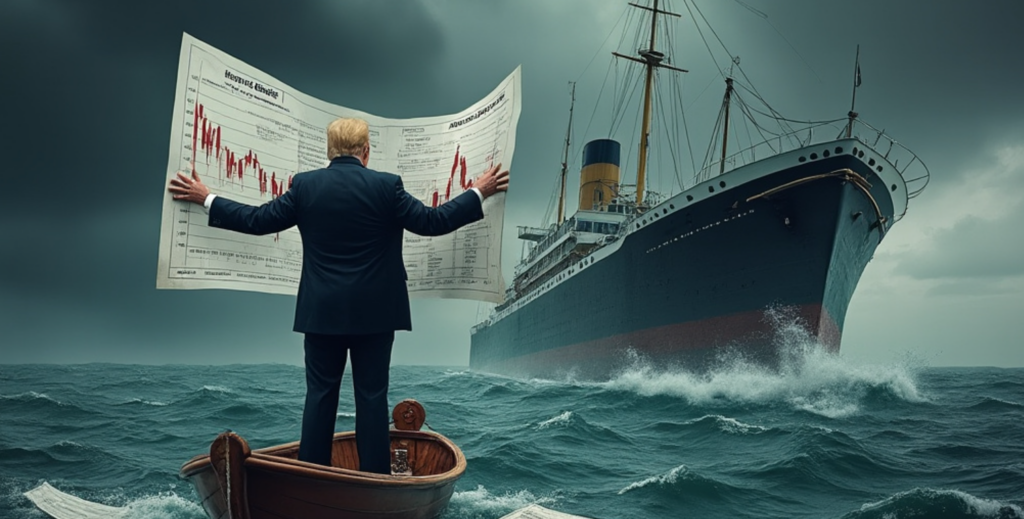The Next Financial Crisis is Coming From Washington, Not Wall Street

The Yield Shock
America’s financial markets don’t speak in headlines.
They speak in prices. Quietly. Relentlessly.
And right now, the message is thunderous:
We don’t trust this.
Since President Trump’s second inauguration on January 20th, U.S. Treasury yields have surged—fast, hard, and across the board.
This isn’t the Fed hiking.
This is the market revolting.
Let’s look at the data:
- The 5-year Treasury yield has jumped from 3.29% to 4.07%.
- The 10-year from 3.58% to 4.47%.
- The 30-year from 3.95% to 4.90%.
That’s nearly a full percentage point increase in under 90 days.
In bond markets, that’s not a ripple. That’s an earthquake.
Yields rise when investors demand more compensation to lend.
That means they see more risk—not in theory, but in the borrower.
And the borrower… is the United States.
Liberation Day: The Trigger
What changed?
April 2nd: President Trump launches Liberation Day—a sweeping tariff order targeting dozens of nations.
Markets recoil. Risk premiums widen. Yields surge.
Wall Street whispers:
“Is this how credibility dies?”
That level of fragility once felt unthinkable for America.
Until now.
Because what began as a trade war… has become a trust collapse.
April 9: A Post, a Pause, a Profit Spike
Then came April 9th.
At 9:37 AM, Trump posts on Truth Social:
“THIS IS A GREAT TIME TO BUY!!!”
At 1:18 PM—less than four hours later—he pauses the tariffs.
Markets explode upward.
The S&P 500 posts its best day since 2009.
Trump Media stock, ticker DJT, jumps 21%.
Coincidence?
Democrats call it the world’s largest pump-and-dump.
Legal scholars cite Rule 10b-5—the statute barring deceptive market manipulation.
And former White House ethics lawyer Richard Painter warns:
“He’s playing with fire. And maybe securities fraud.”
But the bond market saw through the spin.
Because this wasn’t reassurance.
It was a warning sign.
This Isn’t a Crisis. It’s a Repricing of America
In every major crisis—9/11, 2008, COVID—investors fled to Treasuries.
Yields fell. The dollar rose. Safe haven confirmed.
But now?
Yields are rising.
And the dollar is falling.
What happens when the lender stops believing in the borrower?
That combination—surging yields, declining currency—rarely happens in advanced economies.
But in emerging markets? It’s the first signal of sovereign risk.
Think: Turkey. Argentina.
Or the UK in 2022, when Liz Truss’s unfunded tax cuts triggered a bond collapse, a pension liquidity crisis, and her resignation—in 44 days.
That pattern… is appearing in the United States.
Why?
Because this isn’t about tariffs.
It’s about trust.
This isn’t about inflation.
It’s about credibility.
If the world’s largest economy posts stock tips before reversing policy…
If it treats international trade as a provocation, not a partnership…
If it adds $2 trillion in new debt with no plan to fund it…
Then yes—investors will demand higher yields.
And global capital will walk.
The Cost of Losing Faith
If you were a Swiss banker or a Singaporean sovereign wealth fund—
Would you bet your future on a country that runs its bond market on instinct?
This is how a reserve currency becomes a risk asset.
Every basis point rise in yields adds billions in debt service.
That means tighter budgets, weaker defenses, and rising mortgage pain.
Just a 1-point jump in interest adds over $200,000 to a typical 30-year loan.
How many families can absorb that?
Meanwhile, Japan’s central bank has trimmed its Treasury holdings—quietly.
China now holds 42% less U.S. debt than it did a decade ago.
And if yields stay above 4.5%, pension funds may start rebalancing—out of Treasuries, and into foreign debt.
“If this keeps up,” one strategist wrote privately,
“we may have to start pricing the U.S. like a high-yield issuer—not a sovereign anchor.”
Capital flight is accelerating.
Confidence is unraveling.
And the global order America built now questions whether America can afford it.
Let’s be clear:
This isn’t the Fed.
This isn’t a cycle.
This is punishment.
The bond market doesn’t yell.
It doesn’t grandstand.
But it can’t be gaslit.
It whispers.
And lately, those whispers sound like thunder.
The United States doesn’t have to default to trigger crisis.
It just has to doubt itself—loudly enough that the rest of the world hears.
Because financial systems run on belief.
Break that… and you don’t just lose money. You lose stability.
The world’s investors have delivered their verdict:
Fix your house—or we’ll raise the price until you do.
Because no market believes in democracy by default.
It prices what it sees.
And if the United States doesn’t take that seriously…
The next financial crisis won’t start on Wall Street.
It will start in Washington.

